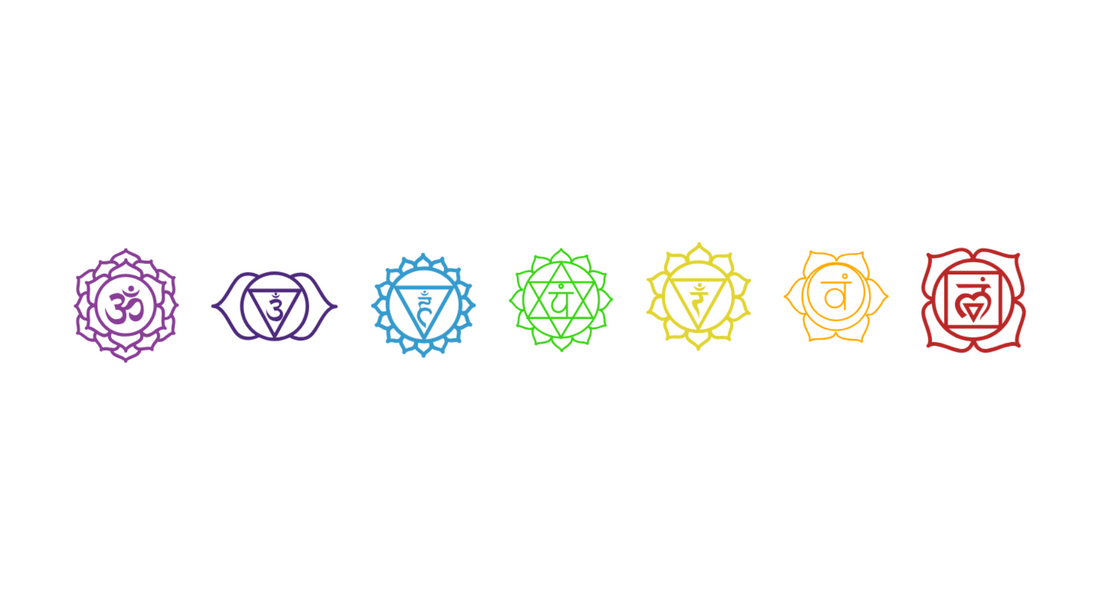The seven chakras are energy centers in the human body, each corresponding to different aspects of physical, emotional, and spiritual health. They are aligned along the spine, from the base to the crown of the head, and are represented by different symbols, colors, elements, and sounds. Here's an overview of each chakra and its associated symbol:
- Root Chakra (Muladhara)
Location: Base of the spine (near the tailbone)
color: Red
Element: Earth
Symbol: A four-petaled lotus flower with a square and an inverted triangle in the center. The square represents stability, and the triangle points downward, signifying grounding and rooting to the Earth. Mantra: Lam
Purpose: The Root Chakra governs survival, security, and grounding. It's associated with our sense of safety and connection to the Earth.
- Sacral Chakra (Svadhisthana)
Location: Lower abdomen, about two inches below the navel
Color: Orange
Element: Water
Symbol: A six-petaled lotus flower with a crescent moon at its center. The petals represent the six fundamental emotions: joy, sorrow, fear, disgust, anger, and desire. The crescent moon symbolizes the fluidity and ebbing nature of emotions.
Mantra: Vam
Purpose: The Sacral Chakra is linked to creativity, pleasure, sexual energy, and emotional balance. It governs our relationships and ability to adapt to change.
- Solar Plexus Chakra (Manipura)
Location: Upper abdomen, around the stomach area
Color: Yellow
Element: Fire
Symbol: A ten-petaled lotus flower with a downward-pointing triangle in the center. The triangle symbolizes transformation and the fire element.
Mantra: Ram
Purpose: This chakra governs personal power, confidence, self esteem, and willpower. It's also related to the digestion and metabolism.
- Heart Chakra (Anahata)
Location: Center of the chest, near the heart
Color: Green (sometimes pink)
Element: Air
Symbol: A twelve-petaled lotus flower with a six-pointed star (the Star of David) in the center. The six-pointed star represents the balance between the feminine and masculine energies.
Mantra: Yam
Purpose: The Heart Chakra is the center of love, compassion, empathy, and emotional healing. It governs relationships with others, self-love, and forgiveness.
- Throat Chakra (Vishuddha)
Location: Throat area
Color: Blue
Element: Ether (Space)
Symbol: A sixteen-petaled lotus flower with a circle and an upward facing triangle in the center. The circle represents sound, and the triangle represents the flow of energy through the throat.
Mantra: Ham
Purpose: The throat chakra is associated with
communication, expression, and authenticity. It governs the ability to express oneself and speak the truth. A balanced throat chakra enhances clarity, self-expression, and effective communication.
- Third Eye Chakra (Ajna)
Location: Forehead, between the eyebrows
Color: Indigo
Element: Light
Symbol: A two-petaled lotus, representing duality and unity, symbolizing insight and higher consciousness.
Mantra: Om
Purpose: The third eye chakra is the center of intuition, perception, and inner wisdom. It influences spiritual awareness, imagination, and mental clarity. When in balance, it fosters clear intuition, insight, and a sense of inner knowing.
- Crown Chakra (Sahasrara)
Location: Top of the head
Color: Violet or White
Element: Thought (beyond the physical elements) Symbol: A thousand-petaled lotus, symbolizing spiritual enlightenment and universal connection.
Mantra: Silence (some traditions use "Om")
Purpose: Sahasrara represents our connection to the divine, universal consciousness, and higher states of awareness. It transcends the self, promoting a feeling of unity with all things. When balanced, it brings enlightenment, inner peace, and a profound sense of connection with the universe.

